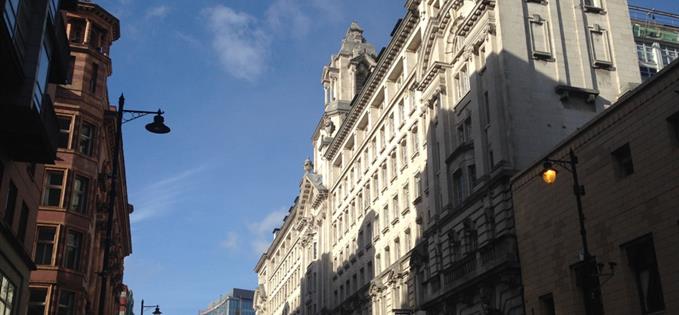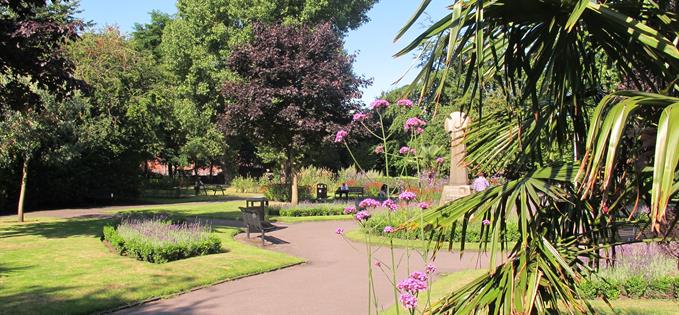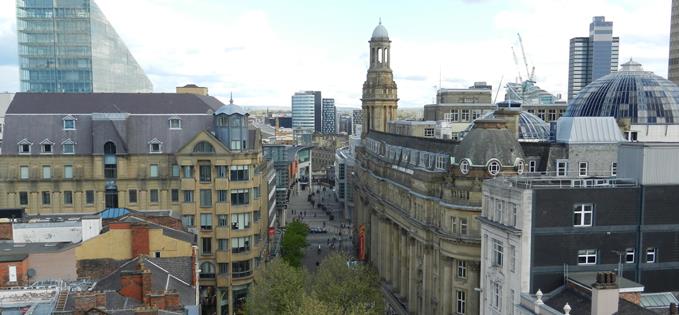THIS is a guest account of Manchester from a woman from Spain, settled in Manchester, who came on one of my tours (Marina is at the back, left of the picture below with her friend, another Spaniard and a civil engineer). What she talked about fascinated me so as Manchester Confidential editor I asked her to put her thoughts down about the city. When intelligent people fresh to the city can give a perspective about Manchester we should listen because they see the city in its raw obviousness, just as we do when we go to Hamburg, Florence or Thessalonika. What she reveals below is the British exceptionalism of our cities. It's an amazing yet strangely heart-warming article. So all that follows are Marina's words... Jonathan Schofield

When I first travelled to Manchester, I knew I was coming to one of the biggest cities in UK, and therefore expected it to be similar to other large European cities I know.
I expected I was going to find a highly dense, extensive city, with an old centre as most of the historic examples in Continental Europe. Well, what I found was not exactly that.
At first, I couldn't explain how it was. People asked me “How is Manchester? Do you like it? Is it beautiful?”
My answer never seemed to be clear enough.
I had to use several phrases trying to explain what Manchester looks like, and always ended with the impression that the other person couldn't get a clear picture of how the city actually is. My description of Manchester was automatically a comparison between the city and my own image of a big city.
So I thought about it and gave myself some questions.
Is Manchester a big city?
Yes, it is. Well, the centre is not huge, but beyond it, the city extends for miles away and I certainly don't know where it stops.
And does it have long streets, big avenues like Avenida Diagonal in Barcelona, or Unter den Linden in Berlin?
There are some principal streets such as Deansgate, Oxford Road or Whitworth Street but no wide avenues or boulevards, and there is not a main street as a vertebrating axis for the structure of the city.

Ok, is it then like an old medieval town with narrow winding streets, nice old houses and small squares?
No, definitely not. Well, in the city centre there are narrow streets, but they are mainly back alleys. And well, yes, you can find some streets with rows of old, low buildings, but is not very common. In the city centre, most of the buildings are four to eight storey constructions built dating from all ages.
Then, it looks like the urban configuration must be based on a grid, like a rational modern city.
Yes, you could say so when you look at a map of Manchester, but certainly that is not the impression you get when you walk around the city.
And what about a river, is the city established along a river?
Yes. In fact, three rivers go through the city, the Rivers Irwell, Irk and Medlock.
And there are canals too that were used as a mean of transport, and industry was located along them. Nowadays you can see boathouses that navigate along the canals, and you can still find some of the old structures such as locks, drawbridges, swing bridges, cranes and old wharfs where the industrial buildings were located. Some of them are still in use, and others have been preserved as a symbol of Manchester's industrial heritage. So it seems like water is important in Manchester.
Is there a big central green area - something similar to Hyde Park in London or the Retiro Park in Madrid?
I’m Spanish and I’m also an architect, which inevitably implies that my personal point of view is influenced by all the theoretical architecture and urban principles learned in university. So the answer is no, there is not a big central park. In fact, there are not many green areas in the centre of Manchester. There are some ‘hidden’ gardens, like St John's Garden, but if you want to find some big green spaces you need to go out of the city centre.

Ok, but is there a big open space in the city, like a central square, a main meeting point for the inhabitants of the city where most of the events historically took place?
Yes, it is called Piccadilly Gardens, although I would say that the main square is Albert Square, where the Town Hall is. Many events in the city also take place in St Ann’s Square, a nice space with St Ann’s Church on one side, and surrounded by pedestrian streets.
No, it is not. The Cathedral is in fact located by the river, at the edge of the city centre. It is a medieval cathedral in a Perpendicular Gothic style, although it has gone through several restorations.
Is that area the Old Town then?
Not anymore. There are a handful of beautiful houses in the traditional English style, with wooden frames and roof structures, but apparently they were moved from a different location. The impression is that the area stands alone unconnected to what is happening around it.
But there must be some old monumental buildings, some impressive stone constructions with a high architectural value.
Yes there are, but their relationship is hard to understand. There are old monumental buildings and big stone constructions, as Manchester has been one of the most important trading and industrial centres in the world, and so it is reflected in its architecture. But the most astonishing buildings in Manchester are the red brick industrial constructions that are spread around the city. Sadly, the industrial character of the city is blurred nowadays, as many of these buildings have disappeared or have been abandoned, but there are plenty still standing that have been turned into houses or offices.

So what is my conclusion? That’s difficult to say. The city does not conform to the European standard. Manchester is a mix of styles, a combination of events and things that have happened during the course of history but are not clearly identified by a mere observer.
Yet that is one of the best things about this city. You need to walk around Manchester to understand it, and by walking and observing it, some kind of constant anxiety emerges forcing you to imagine and think about how the city was in the past.

It is a beautiful experience.
It’s almost an unconscious exercise that the city brings to the observer. The city offers several interesting views of itself, some windows to the past by the combination of old and new architecture, through empty spaces in its centre that the city invites you to mentally fill in, and through the combination of styles and typologies that bring to your mind an imagined picture of the past.
Sadly it has got to a point where it is getting harder to find and recognize those elements that allow you to get a clear reading of Manchester and its history. The destruction of old properties seems to have been a common practice. In addition to that, it seems like the tragic violent destructions that happened in the recent past have not been enough, and the priority now is the economic growth on the basis of modernity and progress.
In my opinion, a city and its inhabitants need to know its history, and this is not possible without the preservation of its architecture. Not only that. Preserving the architecture of a city is not a passive and simple exercise. It has to do with the conservation of the construction itself, but also with the urban environment.
And so, it is important to note that there is more than one way of destroying the architectural heritage. Demolition is the immediate way, but abandonment is a long term destruction which implies the loss of the building's value. And even if the construction is preserved, its richness can be significantly affected by its isolation, either physically (by leaving the building standing alone in the city surrounded by empty spaces), or typologically (by leaving a historic building standing alone surrounded by other constructions with no sort of relationship).
Furthermore, there are other modes of destruction, which may not be so obvious, but are from my point of view, a risky approach to the preservation of the architectural heritage.
One is the conservation of the external appearance of the buildings as a scenery for a completely different use behind, which even if it may not produce a huge impact to the city, can sometimes imply a great loss of the architecture's meaning. And on the opposite side, the desire for preserving the building pure, almost sacred , that generates a conflict with any modern activity or use that could be allocated in it, which results in an empty building, an object with no other purpose than being contemplated.
The truth is there is not a perfect solution, but I strongly believe architectural heritage can perfectly dialogue with modernity, and it is certainly not against progress,despite the apparent inconsistency.
Indeed, I would say architectural richness arises from the combination of both, from the contemporary interpretation of historic spaces, and the transformation into an architecture that complies with the current needs of the inhabitants of the city.
My impression of Manchester is that the city currently stands at a point where either things could be done really badly with a huge impact on the existing architectural heritage or, the city could become a great example of an innovative relationship between the old and the new, with no loss of its essence.
So which path, will Manchester, this untypical (for me) yet strangely beautiful city, take? After all this is my city now.















